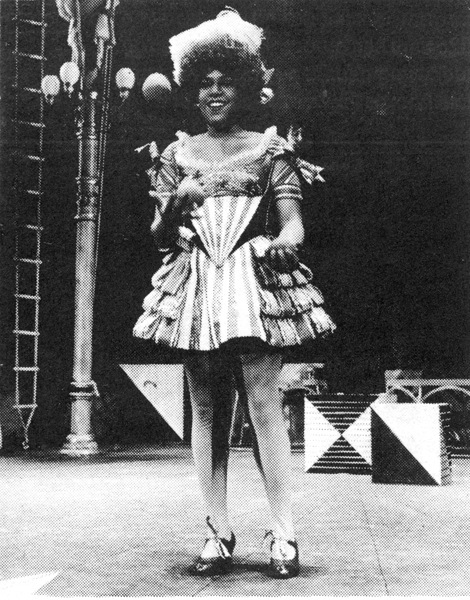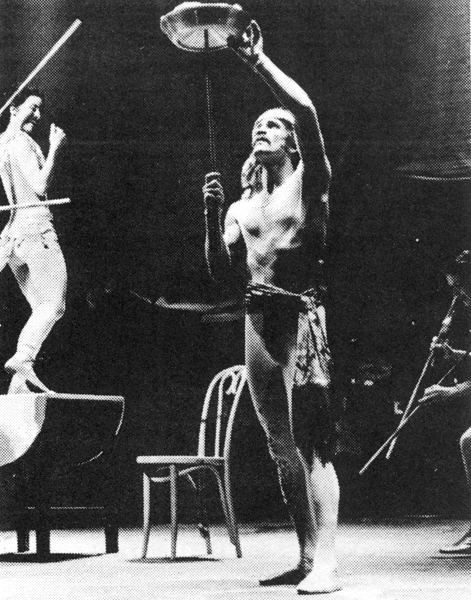
Terri White shows the basic cascade in "Barnum" |

Bill Witter prepares to balance a spinning plate. |
Page 5 March 1981
| GENO: You're
a violinist as well, aren't you?
ROBERTSON:
Yes. I fiddle on the wire. I made , my living as a street
performer doing just that between trees in parks. It was almost
directly as a result of that that I got a part in "Bamum."
Someone who saw me knew Joe Layton and made sure I got an audition. STEVEN
MICHAEL: I was with Ringling for a couple of years as a clown and
did a little ringmaster for the show. I had left Ringling and was
moving around when I heard of "Bamum." I started juggling,
though, when I was sitting on the bench in Little League and had
nothing to do but juggle baseballs. GENO:
What about your balancing of the trombone in the show. Do you ever
drop it? It seems a little dangerous. MICHAEL:
It's not that hard to balance really.
ROBIN
MORGAN: I'm an acrobat and do a lot of flipping all over the
stage. I also do trapeze at the end. I didn't juggle balls very well
before the show, but everybody was juggling when I got here. Eddie
gave me some clubs and really got me interested. BARBARA
NADEL: Interestingly enough, I started juggling when I was a
physical therapist at a hospital in Boston. I used to try to juggle
Ace bandages, but never figured out the pattern or got past two. It
wasn't untill got to Ringling Brothers Clown College that someone
showed me that pattern with three. GENO:
I get the feeling that "Barnum" is a fun show to be in.
I also get the feeling that certain little nuances were added during
rehearsals when the director asked, "Can you do that?"
ROBERTSON:
That's just what happened. When we first started rehearsing we
basically had a room full of toys. I remember one morning Joe Layton
said, "Let me see what you do," and we all went and played. It
gave him a lot of ideas. The cigar boxes that Eddie does for the brick
number started that way. They had written a musical number, "One
Brick At A Time," before they even found out that cigar boxes could
be juggled. So they made up the boxes to look like bricks and now
they're juggled during that song in the show. GENO: It seems that this show is a great mixture between theatre and circus, blending music in a theatrical environment and allowing you to use your circus skills at the same time. Do you find it to be expanding your horizons?
WITTER: I don't know if it's expanding, but I do see it as using all the skills I have available, learned to be an actor, then went off to be a clown and learned other skills. Now I've found a wonderful place to blend them all together
NADEL:
There aren't too many places in legitimate theatre where you can use
your circus skills. That's one of the joys of this show.
ANDY
TlERSTEIN: I'm the only white faced person in this show. Basically,
though, I'm a muscian and play the violin, viola, piano, guitar, banjo,
mandolin and lots of little instruments like the harmonica, spoons and
concertina. I learned juggling from Fred Yokers who taught at State
University of New York in Purchase.
When
I found him, nobody had signed up for his class, but he agreed to work
with me for three hours a day. A couple of others came soon and we had
class eight hours a day. It involved a heavy physical warm-up with
juggling and tumbling. Though juggling was just part of what he taught,
he used it to demonstrate the process of other things. Juggling is
like construction --- a simple process of attempting one skill on top of
the next. You start with one thing and go on to the next and somehow by
its nature each thing interests you in the next thing. Start with one
ball, go on to two, then three and then the tricks lead into each other,
sort of like music. I GENO:
Aguilar is basically a mime teacher if I'm
TIERSTEIN:
Yes. But his strong field is the awareness of the clown. His main
emphasis is clarity: All things have contrast and clarity. Now his
school has become a smooth operation, but is just as intense
GENO:
When they cast "Barnum," did they advertise for jugglers
or for particular roles?
WITTER:
The paper said, "Singer, dancer, actor. Must do all three and
have circus ability. JACOBS:
Circus ability was a must. So, when you came you had to be ready to
show all kinds of skills. It wasn't your average audition. I would have
loved to have seen all the auditions. We saw the last 100 and some were
bizarre! WITTER:
I had just finished teaching at Clown College a month before I got a
call in Seattle. The Felds, who are producers of the circus and part
producers of "Barnum," called me to come to New York. I
auditioned on my unicycle with all my juggling stuff, back pack on my
shoulder and a ladder in one hand. They decided to give me the job, so I
signed a contract and moved my family here.
GENO:
For those people who don't know the New York audition scene, what's
it like to audition for a role on Broadway?
WITTER:
It depends on the show. Most chorus lines are huge. You can end up
being one of 2,000 people auditioning. You show up at 6 a.m. for an 8
a.m. start and sign up as number 629 to go in. But for something like
this not as many people show up. A lot of people might be able to sing
and dance, but they can't tumble, juggle, or do trapeze. |

Terri White shows the basic cascade in "Barnum" |

Bill Witter prepares to balance a spinning plate. |